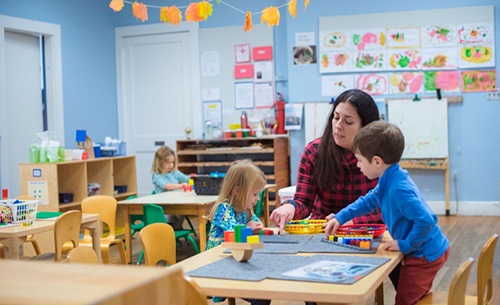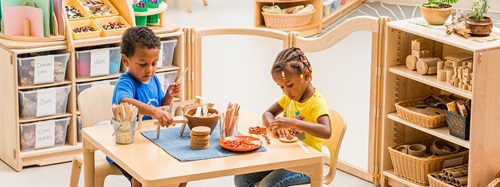Carving Out Time for Wonder:
Reflective Practices in Early Childhood Pedagogy
| March 2022The topic of reflection in early childhood education is often met with a mixture of admiration and frustration. Yes, we all know that reflection is a critical piece of an early educator’s toolbox—a component of practice that deepens our appreciation of, and understanding of, young children. We admire those who do this. However, finding the right time for it—amid busy schedules, packed days, and mounting obligations, (not to mention personal lives that are rich and full!), can be difficult if not frustrating. What, then, can we do to encourage our colleagues and ourselves to find and create time for this reflection that we know is so valuable in our day-to-day practice?
Rooted in Wonder
Reflective practices are rooted in wonder. Wonder, here, refers to a disposition of curiosity that is taken toward an event or phenomenon that we observe. This wonder, in turn, serves as the central motivation behind one’s reflection, leading eventually to a rabbit hole down which an educator feels motivated to travel. This motivation, especially when it is intrinsic, is an important catalyst for reflection. Indeed, there is a unique feeling as one travels down this path of wonder—a so-called rabbit hole—propelled by genuine curiosity. Suddenly, there is no longer an option to stop learning; the sensation of intrigue and joy of making new connections is a self-propelling engine.
Asking “Why?” and “What If?”
A wondering disposition, in turn, invites educators into questions that begin in “Why…?” and “What if…?”. Asking “why” and “what if” questions can deepen an educators understanding of children’s interactions, and also deepen the educators understanding of their reaction and role in the learning. Children’s exploration of themes such as superheroes, animals, or royalty, or their exploration of a certain artistic material, are often common entry points for wonder. Imagine, for example, that the children in your care are endlessly intrigued by a game of kittens, which they enact through a series of rough tackles, dogpiles, and endless laughter.
A child-centered “Why?” might ask: Why are the children so enthralled by this game? Why do the children insist on rough play as part of this game?
An educator-centered “Why?” might wonder: Why am I as an educator so unsettled by the children’s rough and tumble gross motor play?
A child-centered “What if?” might ask: What if the children had other ways to explore the juxtaposition of roughness and tenderness? What if we discussed the purpose and role of rough play in baby animals? Where might this lead and what might it reveal?
An educator-centered “What if?” might wonder: What if I change the language I use to describe play to myself, my colleagues, and in my documentation? What if I made efforts to find a more precise, respectful lexicon to describe the unfolding work of the children?
Making Time: In Your Practice
Just as no one child’s work will be exactly the same in process or in content as the work of another, so too does each reflective practice look different. That is the beauty of authentic reflective practice. However, there are a few principles that might be handy for those seeking to begin, sustain, or re-imagine a reflective practice.
You are already reflecting! You are already reflecting as part of your ongoing work as an educator. As early educators, our entire day is anchored in children: we ask questions about children, we gather data and information about children, about what they know, what they are learning, and the ways that they are experiencing the world.
Regardless of the particular features of your environment—whether, for example, it uses a progressive emergent-curriculum lens, or is a corporate center that must report on particular metrics on a fixed timeframe—as educators we are in the business of reflecting on the lives of children. Internalizing this truth can be helpful as we consider the following points.
- Reframing and rephrasing daily practices and inquiries. The language we use has an important impact on the way we view the world—it is why we are so careful to use precise language with young children. Observing a child spending time writing letters and letter-like forms on a sheet of paper we might move from asking: “What does this child know about letters?” to something like: “I wonder what about letters is intriguing to this child? Their forms? Their communicative potential?”
- Incorporating Others into the Reflective Process. Another efficient way to reflect is to embed it into classroom rituals that already exist, folding others (e.g. colleagues and children) into the process. A simple conversation over snack time counts as reflection—as does wondering, asking, speaking, and thinking with children. This might occur during a regular meeting time, as you walk from one room to another, or over a weekend coffee.
Making Time: In Your Environment and Context
In their book, From Teaching to Thinking, Ann Pelo and Margie Carter note that reflective practices can only exist when they are promoted and provided for in the “visions and values” that “anchor organizational systems.” (2018, p. 103). Succinctly, a critical component of reflective practice and teacher research is making time not only in classroom-based practice, but within the institutional structures within which educators exist.
Making time isn’t necessarily easy, but it is worthwhile. To begin, one might wonder: What works for me? When am I most excited to think about the classroom? Is it in the middle of the day, as the events unfold? During a scheduled planning time? The truth is that there is no way around it, reflective practice takes time—however, it needn’t be laborious.
Perhaps this time begins with a reflective minute appended to a break (to use the restroom, grab coffee, eat a snack, etc.) A reflective minute inviting yourself to wonder is the perfect spot to begin—inserted here and there over the course of days and weeks, these minutes add up. As you continue to work to find these moments, they will become easier and more efficient.
The Fruits of Reflection: Cultivating Intentionality
The fruits of reflection are many—including, but not limited to, increased intentionality, more entrenched habits of inquiry, and perspective shifts that have the potential to impact the ways we view ourselves, our colleagues, and the children with whom we work.
- Intentionality. Reflection and intentionality are a closely related, perhaps even mutually-informative, pair. Reflection leads to intentionality and an intentional stance necessarily incorporates reflection. For example, when you watch, patiently, as children enact, through play, rituals of waking, eating, and dressing, you might reflect on anything from what children view as most important about these rituals, to the sorts of questions you’d like to discuss with the children at your next meeting relating to this play, to some things you might bring up with a coworker or colleague, to your own wondering about how these rituals connect to broader societal norms, etc.
- Habits of Inquiry. Reflective practices also help us establish habits of wondering and inquiry. When we are able to incorporate reflective minutes, reflective rituals, and reflective frames of mind into our ongoing daily work, these habits of inquiry become increasingly second nature. This means that we will begin to be reflective right where we are—as we attend a faculty or staff meeting, as we work with children to navigate conflict, as we observe children’s play ebbing, flowing, and evolving.
- Perspective Shifts. Reflecting frequently and in the company of others invites us to look outside of ourselves and our own experiences for answers. This occurs through discussions and dialogue with ourselves, others, ideas, etc. When we reflect, even on our own previous conceptions, we learn to let go of our established ideas and frameworks. This propels us onward in the search of more answers that will lead us along the paths of wonder and awe.
The most important thing we can do as educators is to maintain a reflective disputation toward our practice. There is always room to begin anew, deepen your existing practice, and to discern what works best for your particular interests, needs, and context. Reflection and its fruits are, ultimately, a testament to an image of children as capable human beings who lead rich lives, hold complex ideas, and experience the world deeply.











